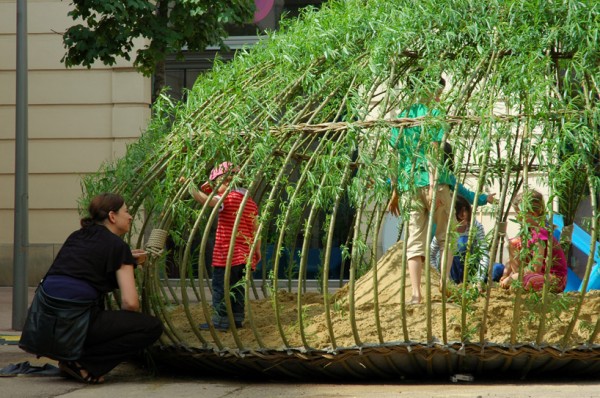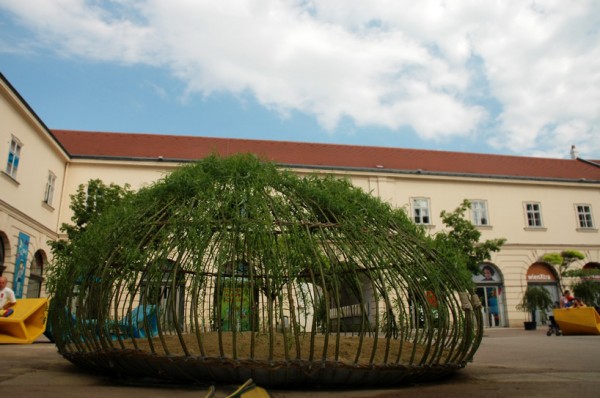Green playgrounds seem to be popping up everywhere these days. From swings and teeter totters that produce juice when kids engage with them to jungle gyms that teach children about renewable energy to playground equipment actually upcycled from old turbine blades, designers are rethinking the ways that playgrounds are constructed. The ‘kagome’ by PPAG of Austria (which comes to us via Designboom) adds a new design concept to the conversation: a playground so organic that it’s grown, rather than constructed.
The firm collaborated with Simon Oberhammer and Stefanie Mayer to create this unique piece of playground equipment, located in the museums quarter of Vienna. Functioning as a kind of tot-lot/sandbox, the structure was formed using 120 live willow saplings bent to create an enclosure. The rooted plants were secured in place with rings of wood woven with raffia. Each willow tree, at the time of the structure’s creation, stood 5 meters (around 16 feet) tall and 4 centimeters (around 2 inches) in diameter. Over the course of the summer, these trees will continue to grow, shading the kids within the playground area from the heat and glare of the sun.

The vegetation in the kagome is rooted in a central humus bag, which is then covered over in sand. Irrigation is handled by a network of watering hoses integrated into the base of the structure beneath the top layer of sand, making the whole thing relatively maintenance free (provided romping tots don’t knock the tubing loose).
The term ‘kagome’ actually derives from a the kagome lattice, a term formed by the conjunction of two Japanese words meaning the pattern of holes (“me“, literally “eyes”) in a basket (“kago“). The term is used in physics to refer to certain atomic arrangements within crystalline structures. Here, it appears to applied more loosely, but in a way that is, perhaps, equally appropriate. Not only is this sandbox contained in a kind of living basket, woven together out of wood, it contains a pattern of holes that allows little eyes to look out (and watchful parental eyes to look in).

This seems a thoughtful playground design, not just in terms of being friendly to the environment, but in terms of being friendly to parents. By containing kids who’ve just discovered the wonders of locomotion, the structure gives parents a respite from that endless running around associated with toddlers. By giving some of the smallest kids at the playground a place to explore that feels secret (not unlike a little woodland fort), it imparts a sense of adventure and independence. And by keeping the line of sight open from parents to kids through that lattice-like basket structure, the kagome keeps that exploration safe and fun for both parties.
During the construction phase of the kagome, temporary steel rings were used to bend the willow saplings into the desired shape. After they achieved that shape and were woven together, the steel rings were removed, leaving a structure formed only with natural elements.